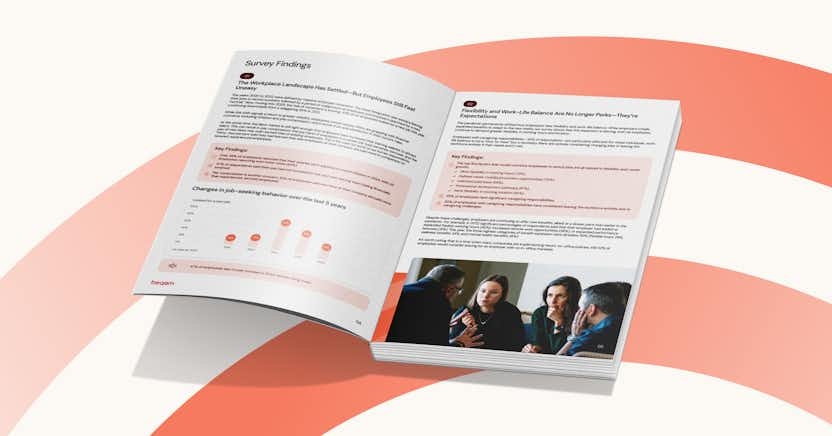5 Steps to Making HR More Strategic, Part I: Creating Value

As any CHRO can tell you, the role of Human Resources (HR) is undergoing a profound transformation. The potential of HR to impact business outcomes has never been greater. Yet, while the strategic importance of HR is undeniable, it is not always perceived as such. To truly fulfill its strategic potential, HR must be focused and tech-savvy, to move beyond the realm of administrative duties and into the forefront of organizational success.
For HR executives seeking to lead their teams into a more strategic future, the secret lies in having a vision and harnessing the power of HR technology to make the vision a reality. This transformative journey involves not only streamlining administrative processes but also redefining the way HR engages with people, measures results, and contributes to the company culture and overall business strategy.
Technology is important because, as it advances, it not only creates efficiencies, it makes possible new ways of operating that can transform the business and drive results.
In this series of two blogs, we will guide HR leaders through "5 Steps to Make HR More Strategic," with a focus on leveraging technology for a comprehensive transformation. From automating time-consuming tasks to aligning HR initiatives with overarching business goals, this roadmap aims to empower HR professionals to transcend traditional boundaries and become architects of strategic success.
In part I of our two-part series, we will examine the first 3 steps on the path to strategic HR, which set the foundation.
- Step 1: Streamlining Administrative Processes with HR Technology
- Step 2: Evaluating and Identifying Strategic Levers
- Step 3: Fostering a People-Centric Focus through HR Initiatives
In part II we will consider ways to measure success and take action to finalize the transformation to strategic HR:
- Step 4: Measuring Success with Key Metrics
- Step 5: Actionable Strategies for HR Transformation
Step 1: Streamlining administrative processes with HR technology
In the pursuit of a more strategic HR function, the initial step involves liberating HR professionals from the shackles of administrative burdens through the adoption of cutting-edge HR technology. These systems act as catalysts for change, revolutionizing the way tasks such as compensation management and performance processes are handled.
Does this make HR more strategic or just more efficient? Really, it’s both. Efficient HR systems reduce the workload for HR professionals and also deliver benefits to managers and employees. By automating time-consuming tasks, these technologies free up valuable resources, allowing HR to shift its focus from spreadsheet shuffling to strategic initiatives that directly impact organizational outcomes.
Finding the optimal technologies
Many companies are finding that by utilizing best-of-breed HR solutions, rather than trying to accomplish everything with a one-size-fits-all HR software suite, they can take advantage of technology innovation and build an HR tech stack that delivers value and a top-notch user experience.
Consider, for instance, the potential transformative impact of a best-of-breed total compensation platform that seamlessly manages compensation structures and pay equity. This not only streamlines compensation cycles and enables more flexible rewards, but also ensures fairness and transparency, critical elements in attracting and retaining top talent, not to mention being an important foundation for legal compliance. As a result, HR has both the capability and the time to devise and implement compensation strategies that align with the company's overarching goals.
Furthermore, such technology-driven efficiencies don't merely stop at the HR department's doorstep. Managers and employees benefit from streamlined processes, enabling them to concentrate on core responsibilities rather than getting entangled in bureaucratic procedures. The result is a more agile and responsive workforce, ready to contribute to the organization's strategic objectives.
Step 1 lays the foundation for a strategic HR function by recognizing the transformative potential of technology to reduce administrative overhead and provide rich functionality to support better ways of doing things.
Step 2: Evaluating and identifying strategic levers
With administrative processes streamlined and optimized, the next critical step for HR in becoming more strategic involves a deliberate evaluation of the levers it possesses to drive meaningful impact within the organization. These levers hold the potential to unlock doors leading to enhanced business outcomes.
Finding your strategic levers
Senior HR executives will need to engage in some introspection and analysis to identify these strategic levers. This involves assessing the unique strengths and capabilities of the HR function, understanding where it can exert the most influence, and aligning those areas with the broader goals of the organization.
Consider, for example, the power of an HR team that recognizes its ability to shape the company's culture and employer brand. By deliberately curating a workplace environment that reflects the organization's values and appeals to top talent, HR becomes an architect of the company's identity. This strategic lever not only impacts employee satisfaction and retention but also shapes how the organization is perceived in the competitive market.
Quantifying your objectives
Once these levers are identified, the next crucial step is to assign specific, measurable objectives to each one. Whether it's optimizing the recruitment process, transforming performance evaluation systems, implementing pay equity and transparency practices, or enhancing employee or leadership development initiatives, clarity in objectives is paramount. This precision guides the strategic focus of HR and provides a framework for measuring results. Having the right workforce analytics can aid in measuring attainment of objectives.
Strategic HR success stories
Success stories abound where organizations have strategically identified and leveraged their HR strengths. By aligning HR objectives with broader business goals, senior HR leaders can propel their teams to become indispensable contributors to organizational success. This deliberate focus on strategic levers sets the stage for a more purposeful and impactful HR function, one that transcends the traditional boundaries of transactional HR activities.
To help you understand what we mean by strategic levers, here are a few examples of organizations that strategically identified and leveraged their HR strengths, resulting in tangible success:
Google's innovative workplace culture
Strength identified: Google recognized its unique workplace culture as a strategic lever.
Leveraging the strength: The company invested heavily in creating a distinctive and employee-friendly work environment, fostering creativity and collaboration.
Success outcome: Google's innovative reputation not only attracted top talent but also contributed significantly to its position as a technology leader.
Zappos' focus on employee satisfaction
Strength identified: Zappos identified employee satisfaction as a key HR strength.
Leveraging the strength: The company focused on creating a positive and engaging workplace, emphasizing employee happiness and well-being.
Success outcome: Zappos' commitment to employee satisfaction resulted in high retention rates, a positive brand image, and improved customer service.
IBM's strategic talent acquisition
Strength identified: IBM recognized talent acquisition as a critical HR strength.
Leveraging the strength: The company invested in advanced recruitment technologies and strategic talent acquisition initiatives to attract and retain top talent.
Success outcome: IBM's strategic approach to talent acquisition contributed to its leadership position in the technology and consulting industry.
Netflix's performance culture
Strength identified: Netflix identified a performance-driven culture as a key HR strength.
Leveraging the strength: The company implemented a unique approach to performance management, emphasizing continuous feedback and a focus on high performance.
Success outcome: Netflix's performance culture contributed to its reputation for innovation and agility in the highly competitive streaming industry.
Salesforce's commitment to equality and inclusion
Strength identified: Salesforce recognized diversity and inclusion as a strategic HR strength.
Leveraging the strength: The company implemented comprehensive diversity and inclusion initiatives, including pay equity measures and employee resource groups.
Success outcome: Salesforce's commitment to equality and inclusion not only enhanced its employer brand but also contributed to a more innovative and collaborative workplace.
These examples demonstrate how organizations, by strategically identifying and leveraging their HR strengths, were able to achieve positive results in areas such as talent acquisition, workplace culture, employee satisfaction, and innovation. Each story underscores the transformative impact of aligning HR initiatives with broader organizational goals. What are some existing strengths of your HR function that you can get behind to produce results that will make a difference?
Step 3: Fostering a people-centric focus through HR initiatives
Having streamlined administrative processes and identified strategic levers, the next pivotal step in elevating HR's role involves embracing a people-centric HR strategy. HR, as the custodian of an organization's human capital, plays a paramount role in shaping a high-performing culture—one marked by continuous feedback and relentless commitment to improvement.
Putting people first is not always as easy as it sounds. It takes commitment, planning, and a strong people-oriented compass. For example, it may mean selecting the technology that will deliver the most value and the best experience for your employees instead of the one-size-fits-all standardization that IT may promote. When you have a truly people-centric mindset, it guides every decision, from recruitment to employee development, engagement, rewards, and pretty much any human resources process or practice.
Creating a high-performing culture
HR is perhaps in a better position than any other function to influence the heart of organizational dynamics—the culture. Recognizing that people are the driving force behind any company's performance, HR can proactively mold the workplace environment. By championing values, encouraging collaboration, and fostering innovation, HR can become the architect of a culture that propels employees to perform at their peak.
A high-performing company is one where employees feel empowered, engaged, and aligned with the organization's goals. HR can introduce initiatives such as regular town hall meetings, team-building activities, and open communication channels, along with providing enabling technologies to nurture this collaborative ethos. This people-centric focus not only enhances job satisfaction but also contributes to a more resilient and adaptable workforce.
Continuous feedback and improvement
Central to creating a high-performing culture is the establishment of a feedback loop that fuels continuous improvement. HR can institute mechanisms for regular, constructive feedback, moving beyond the traditional annual performance reviews. By fostering a norm of continuous feedback, employees receive timely insights into their performance, enabling them to adapt and grow.
Implementing feedback mechanisms is not solely the responsibility of HR but involves collaboration with managers and team leaders. HR can facilitate training programs on effective feedback delivery and implement platforms (such as beqom Continuous Performance Management) that encourage open dialogue. This commitment to ongoing improvement ensures that the organization remains agile in response to evolving challenges.
Consider the transformative impact when HR takes the lead in instituting a mindset of continuous improvement. Teams become more adaptable, learning from successes and setbacks alike. Employees feel valued and supported in their professional development, contributing to higher levels of engagement and loyalty.
Step 3 emphasizes HR's pivotal role in creating a high-performing culture, where continuous feedback and improvement are not just encouraged but ingrained in the organizational DNA. By prioritizing people-centric initiatives, HR sets the stage for a workplace where every individual is motivated to excel, aligning their efforts with the broader strategic goals of the organization.
Measuring results and taking action
In part II, we will examine the next critical steps in making HR more strategic, through the systematic measurement of success and employing actionable strategies.
If you have questions about how HR can become more strategic, and how technology can transform your HR processes and help you build a high-performing organization, please reach out and contact us at beqom today.















